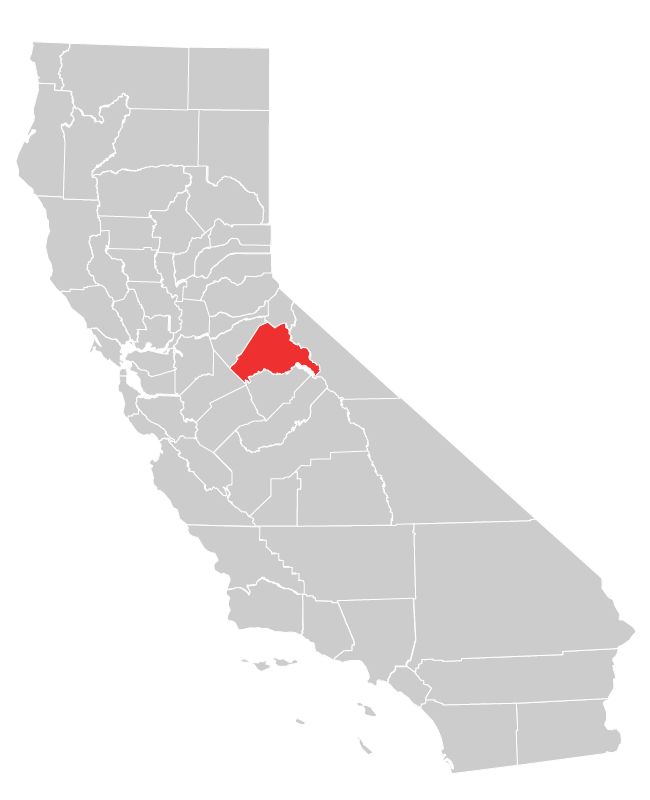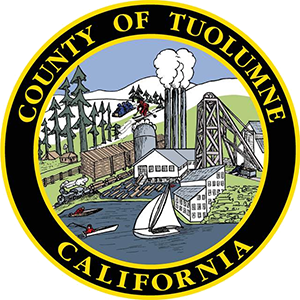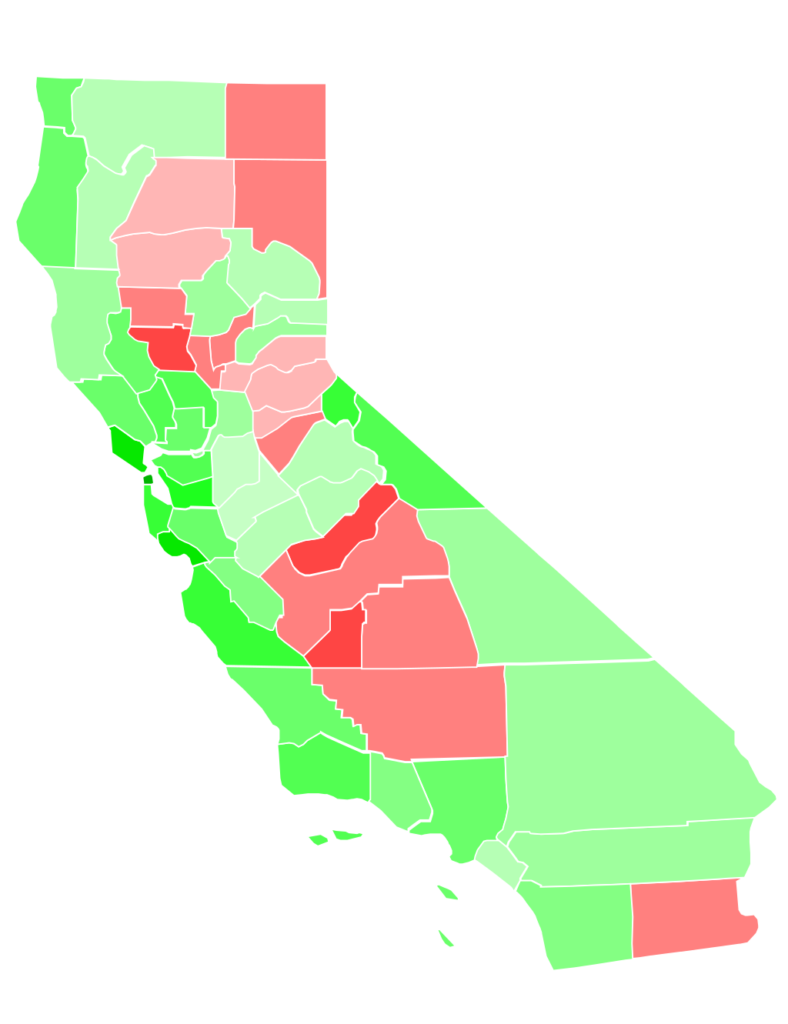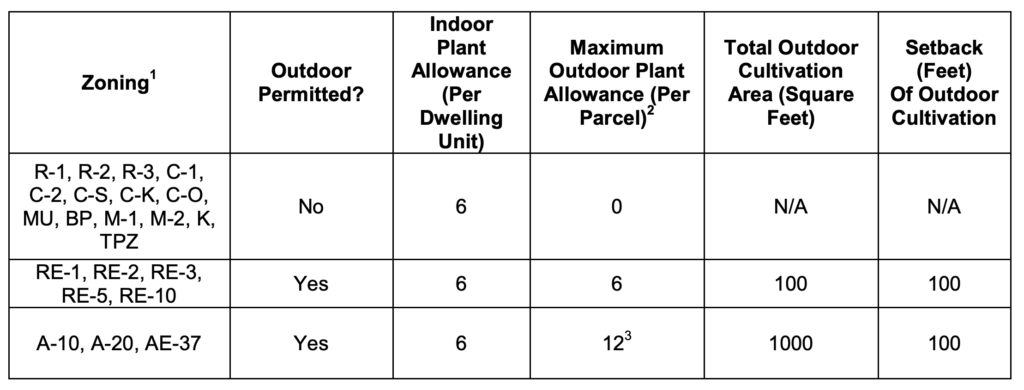
Rogoway Law » Resources » California Cannabis Laws By County » Tuolumne County Cannabis Laws

Per Tuolumne County Ordinance Code 17.67.065, all commercial cannabis activities requiring a state license are prohibited. These commercial cannabis activities include, but are not limited to, cultivation, processing, manufacture, distribution, testing, and sale. Per the existing law, commercial cannabis activities are declared to be a public nuisance and each property owner or other responsible person is subject to abatement and administrative penalties as provided for by the Code.
While all commercial cannabis activity is prohibited in unincorporated Tuolumne County, the County is currently in the process of researching commercial cannabis activities.
Please note that the Tuolumne County cannabis ordinances and regulations described on this page only affect the cannabis businesses seeking to domicile or already domiciled within the unincorporated areas of the County of Tuolumne.
Cities within any California County, which are incorporated entities themselves, often have separate regulations, permitting applications, as well as permit limits.
Municipalities in Tuolumne County that permit cannabis operations in some capacity:

On November 8, 2016, a majority – 52.3% – of voters in Tuolumne County voted in favor of legalizing commercial cannabis in California under Prop 64: The Control, Regulate and Tax Adult Use of Marijuana Act (AUMA):
Cannabis regulations and resources from Tuolumne County:
The Board of Supervisors of the County of Tuolumne finds and declares as follows:
A. In 1996, the voters of the State of California approved Proposition 215 (codified as California Health and Safety Code section 11362.5 and titled the “Compassionate Use Act of 1996”).
B. The intent of Proposition 215 was to enable persons who are in need of cannabis for medical purposes to be able to obtain and use it without fear of criminal prosecution under limited, specified circumstances.
C. In 2004, Senate Bill 420 was enacted (codified as California Health and Safety Code section 11362.7 et seq. and titled the “Medical Marijuana Program Act”) to clarify the scope of the Compassionate Use Act of 1996. The Medical Marijuana Program Act allows counties to adopt and enforce rules and regulations consistent with its provisions.
D. In 2011, Assembly Bill 2650 was enacted (codified as California Health and Safety Code section 11362.768). This law affirms that counties can adopt ordinances that restrict the location and establishment of medical cannabis collectives and cooperatives.
E. In 2015, Assembly Bills 243 and 266 and Senate Bill 643 were enacted (codified as California Business and Professions Code section 19300 et seq. and titled the “Medical Cannabis Regulation and Safety Act”). These bills also amended provisions of the Medical Marijuana Program Act related to the cultivation of medical cannabis.
F. In 2016, the voters of the State of California approved Proposition 64 (codified as California Health and Safety Code section 11362.1 et seq. and California Business and Professions Code section 26000 et seq. and titled the “Adult Use of Marijuana Act”).
G. The purpose of the Adult Use of Marijuana Act was to establish a comprehensive system to legalize, control and regulate the cultivation, processing, manufacture, distribution, testing, and sale of nonmedical cannabis, including cannabis products, for use by adults 21 years and older, and to tax the commercial growth and retail sale of cannabis. Additionally, the Adult Use of Marijuana Act allows persons 21 years of age or older to possess, plant, cultivate, harvest, dry or process not more than six living cannabis plants within a single private residence, or upon the grounds of that private residence, at one time.
H. On June 27, 2017, Senate Bill 94 was enacted, combining the Medical Cannabis Regulation and Safety Act and the Adult Use of Marijuana Act into the Medicinal and Adult-Use Cannabis Regulation and Safety Act.
I. Pursuant to California Business and Professions Code section 26200(a), nothing in the Medicinal and Adult-Use Cannabis Regulation and Safety Act shall be interpreted to supersede or limit the authority of a local jurisdiction to adopt and enforce local ordinances to completely prohibit the establishment or operation of one or more types of businesses licensed under the Medicinal and Adult-Use Cannabis Regulation and Safety Act within the local jurisdiction. Additionally, California Health and Safety Code section 11362.2(b) authorizes the County to enact and enforce reasonable regulations regarding the personal, non-commercial cultivation of cannabis.
J. This Chapter is enacted, consistent with the Compassionate Use Act of 1996, The Medical Marijuana Program Act, and the Medical and Adult-Use Cannabis Regulation and Safety Act to protect the public health, safety, and welfare of County of Tuolumne residents in relation to the cultivation, processing, manufacture, distribution, testing, and sale of cannabis.
K. In Maral v. City of Live Oak (2013) 221 Cal.App.4th 975, the appellate court held that neither the Compassionate Use Act nor the Medical Marijuana Program Act preempt a local jurisdiction’s police power to prohibit the cultivation of cannabis within its jurisdiction.
L. Although banned in Tuolumne County under the principles of permissive zoning, cannabis grows have been operating in the County of Tuolumne for several years and have been the subject of home invasions, armed robberies with shots fired, incidents with juveniles and young adults, and closure and arrests of operators for violation of both state and federal laws, including seizure of illegal firearms. Other public entities have documented violence related to operation of cannabis grows. Cannabis cultivation attracts crime and associated violence and results in loitering, increased traffic, noise, and a loss of trade for other business located nearby. Cannabis grows have proliferated in the County of Tuolumne resulting in numerous complaints by the public to the Sheriff and members of the Board of Supervisors of prevalent malodorous conditions and safety concerns.
M. The claim of many cannabis cultivations as being designed to assist authorized medical cannabis users fails to consider the fact many cultivations have simply served as avenues for the exportation and distribution of cannabis for illegal use. Further, cannabis cultivations have been shown to involve avoidance of environmental laws and regulations and resulted in the pollution of waters and navigable waterways in the County of Tuolumne and beyond. Cannabis cultivations are harmful to the welfare of the surrounding community and its residents and constitute a public nuisance. All of these problems seem to worsen as the cultivations become larger. Cannabis grows have been found in Tuolumne County to be of extraordinary size, measured in multiple acres or otherwise in quantity far in excess of what might be cultivated for medicinal use.
N. The federal Drug Enforcement Administration reports that various types of cannabis plants under various planting conditions may yield averages of 236 grams, or about ½ pound, to 846 grams, or nearly two pounds. The “street value” of a single cannabis plant is substantial. Pound prices for domestically produced high grade cannabis sold illegally within Northern California can range from $1,500 to $3,000. A single cannabis plant can easily yield $4,000 or more in salable cannabis. One pound can yield 908 cannabis cigarettes.
O. Investigation of cultivations has revealed that some property owners claim not to know of cannabis cultivations on their property or ignore cultivations, all to the prejudice of the people in the surrounding areas, and demonstrating the need for owner responsibility for activities on their properties.
P. Cannabis cultivation in the County of Tuolumne poses an urgent and immediate threat to the public peace, health, and safety. Several cannabis cultivations have recently emerged in the County of Tuolumne which are very visible to the public, and easily accessible by the public, including children and youths. Some of these cultivations contain hidden dangers that threaten severe bodily harm or death to those who attempt to access them. During the current harvest, and each harvest and processing season, there is an immediate threat of violent crime due to the size, location, and monetary value of these mature cannabis cultivations.
Q. According to the Tuolumne County Sheriff, the U.S. Drug Enforcement Administration, and as shown in other counties, cannabis growers may go from county to county, based on how vigorously each locale may regulate grows, fostering large criminal enterprises and prepared to accept low risk in favor of large economic reward, all to the disadvantage of the health and welfare of the local population.
R. According to the Tuolumne County Sheriff, the U.S. Drug Enforcement Administration, and as shown in other counties, cannabis cultivations create a nuisance and threaten the safety and property of nearby land owners and their families. If cannabis grows are not immediately regulated, large quantities of illegal cannabis will be introduced into the local market in the near term.
S. Cannabis, alone or in combination with food products, may constitute a unique health hazard to the public because, unlike all other ingestibles, cannabis is not presently regulated, inspected, or analyzed for contamination by the state or federal government and likely contains harmful chemicals and contaminants from unapproved sources that could endanger the already poor health of ill persons and the good health of others.
T. Cannabis varies in quality, with significant variations in the concentration of the active ingredient tetrahydrocannabinol (THC). Consumers cannot accurately ascertain the strength of the drug when they buy it. Also, it cannot be assured that customers will be adequately warned that cannabis use impairs the user’s fine motor skills and negatively affects the safe operation of motor vehicles.
U. The County of Tuolumne has a compelling interest in protecting the public health, safety, and welfare of its citizens, residents, visitors and businesses, in preserving the peace and quiet of the neighborhoods within the County and in providing access to medical cannabis for ill residents.
V. The adverse effects from cannabis cultivation and distribution may increase as the crop continues to grow, thereby requiring quick action to protect the public.
W. Other counties in California have encountered similar problems from the unregulated cannabis grows and have attempted to regulate them by ordinances after their respective boards of supervisors found such action to be necessary. Investigations have revealed that some growers have come to this County because it does not have an express regulation to deal with grows.
X. Nothing in this Chapter shall be deemed to conflict with federal law as contained in the Controlled Substances Act, 21 U.S.C. § 841 or to license any activity that is prohibited under said Act except as mandated by State law.
Y. Nothing in this Chapter shall be construed to: (1) allow persons to engage in conduct that endangers others or causes a public nuisance; (2) allow the use of cannabis for nonmedical purposes in excess of that authorized by the Medicinal and Adult-Use Cannabis Regulation and Safety Act; or (3) allow any activity relating to the cultivation, distribution, or consumption of cannabis that is illegal under state or federal law.
It is the purpose and intent of this Chapter to prohibit the commercial cultivation, processing, manufacture, distribution, testing, and sale of medical or nonmedical cannabis in order to protect the environment and preserve the public peace, health, safety, and general welfare of the citizens, residents and travelers through the County of Tuolumne and to implement reasonable regulations for the personal cultivation of cannabis.
This Chapter is not intended to, nor shall it be construed or given effect in a manner that causes it to apply to, any activity that is regulated by federal or state law to the extent that application of this Chapter would conflict with such law or would unduly interfere with the achievement of federal or state regulatory purposes. It is the intention of the Board that this Chapter shall be interpreted to be compatible and consistent with federal, state, and County enactments and in furtherance of the public purposes which those enactments express. It is the intention that the provisions of this Chapter will supersede any other provisions of this Code found to be in conflict.
For purposes of this Chapter, these words and phrases shall be defined as follows:
A. “Cannabis” shall have the same definition as ‘cannabis’ as set forth in California Business and Professions Code section 26001(f) as it now reads or as amended.
B. “Cultivate” or “cultivation” is the planting, growing, harvesting, drying, processing, or storage of one or more cannabis plants or any part thereof in any location and shall include the definition as set forth in California Business and Professions Code section 26001(l) as it now reads or as amended.
C. “Indoor” or “indoors” means within a fully enclosed and secure structure that has a complete roof enclosure supported by connecting walls extending from the ground to the roof, securely anchored, and in compliance with Title 15, Buildings and Construction, of this Code. The structure shall be secure against unauthorized entry, accessible only through one or more lockable doors. For purposes of this Chapter, cultivation within a detached structure accessory to the dwelling unit shall be considered indoor cultivation if the structure satisfies the requirements of this definition; otherwise, it shall be considered outdoor cultivation. Standard zoning setbacks requirements apply to all accessory structures.
D. “Outdoor” or “outdoors” means any location that is not “indoor” or “indoors” as defined in this Chapter.
E. “Place of worship” means a structure or leased portion of a structure, which is used primarily for religious worship and related religious activities.
F. “School” means an institution of learning for minors, whether public or private, offering a regular course of instruction required by the California Education Code. This definition includes a nursery school, kindergarten, elementary school, middle or junior high school, senior high school, or any special institution of education, but it does not include a home school, vocational or professional institution of higher education, including a community or junior college, college, or university.
G. “School evacuation site” means any location designated by formal action of the governing body, Superintendent, or principal of any school as a location to which juveniles are to be evacuated to, or are to assemble at, in the event of an emergency or other incident at the school.
H. “Sensitive uses” means schools, school evacuation site, places of worship, public parks, licensed family day care home/day care center, youth-oriented facilities, public libraries, playgrounds, youth recreation centers, licensed drug or alcohol recovery facilities, licensed sober living facilities, and federal lands.
I. “Youth-oriented facility” means any facility that caters to or provides services primarily intended for minors, or the individuals who regularly patronize, congregate or assemble at the establishment are predominantly minors.
A. The cultivation of cannabis for personal, non-commercial use shall be restricted by zoning district as follows:

B. Regulations applicable to all personal, noncommercial cultivation.
C. Regulations for Indoor Cultivation
D. Regulations for Outdoor Cultivation
E. In addition to the regulations set forth in Sections B and C, accessory structures that meet the definition of “indoor” and utilize transparent or translucent building material for walls shall comply with the regulations set forth in Section D(1) and (3).
Notwithstanding Chapter 17.58 of this Code, the establishment, maintenance, or operation of any prohibited cultivation of cannabis, as defined in this Chapter, within the unincorporated areas of the County of Tuolumne is declared to be a public nuisance and each property owner or other responsible person is subject to abatement and administrative penalties as provided for by this Code. In the event a new sensitive use is sited within one thousand (1000) feet of a parcel engaging in cultivation within a transparent or translucent accessory structure pursuant to Section 17.67.050(E) and otherwise compliant with the provisions of this Chapter, said cultivation shall be treated as a nonconforming use pursuant to Chapter 17.58 of this Code. In the event a new sensitive use is sited within one thousand (1000) feet of a parcel engaging in outdoor cultivation pursuant to Section 17.67.050(D) and otherwise compliant with the provisions of this Chapter, the parcel shall have eighteen (18) months to convert said cultivation to indoor cultivation.
The establishment, maintenance, or operation of any commercial cannabis activity, including, but not limited to, cultivation, processing, manufacture, distribution, testing, and sale, which would require a state license to be issued pursuant to the Medical Cannabis Regulation and Safety Act or the Adult Use of Cannabis Act is prohibited within the unincorporated areas of the County of Tuolumne and declared to be a public nuisance and each property owner or other responsible person is subject to abatement and administrative penalties as provided for by this Code.
Notwithstanding Section 17.72.060, this Chapter shall be enforced as provided for in Chapter 1.10 of this Code by the Code Compliance Officer and the Tuolumne County Sheriff and/or their designees. The Sheriff’s primary role shall be to ensure safety and provide technical support. (Ord. 3327 § 1, 2018; Ord. 3326 § 2, 2018; Ord. 3294 § 1, 2016)
Our newsletter provides valuable information for businesses, often including the latest legal developments affecting the industries we serve.
© 2025 Rogoway Law Group, P.C. | All rights reserved.